Foreign Wars (3rd century BC)
King Pyrrhus in Sicily (278 - 6 BC)


Foreign Wars (3rd century BC)
King Pyrrhus in Sicily (278 - 6 BC)
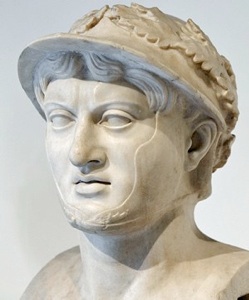
Marble bust, usually assumed to by of King Pyrrhus, from the Villa of the Papyri , Herculaneum,
(possibly a Roman copy (1st century BC) of a Hellenistic bronze original),
now in the National Archaeological Museum of Naples (from Wikipedia)
King Pyrrhus of Epirus
In ca. 280 BC, the Greek city of Tarentum in southern Italy secured the services of the King Pyrrhus of pirus in what proved to be the start of the so-called Pyrrhic War.
Timaeus’ Historical Works
A now-corrupt entry in the ‘Suda’ indicates that Timaeus was also the author of ‘Italica and Sicelica’ in <thirty->eight books. This would have been a ‘local’ history of the Greek cities of Sicily and southern Italy, in a recognised tradition comparable to those of other Greek localities across the Mediterranean. Thus, for example, the Romano-Jewish historian Flavius Josephus (late 1st century AD) criticised discrepancies between successive historians who belonged to some of these distinct traditions:
“Even on Sicilian history, Timaeus did not condescend to agree with [the Syracusan historians] Antiochus [4th century BC], Philistus [ca. 300 BC], or Callias [ca. 300 BC]; there is similar divergence on Attic affairs, between the authors of the ‘Atthides’; and on Argive affairs, between the historians of Argos”, (‘Against Apion’, 1: 17-8, translated by Henry St John Thackeray, reference below, at p. 171).
According to Christopher Baron (referenced below, at pp. 30-1), it probably began with the mythological ‘history’ of the western Mediterranean and ended with a long tirade (in five chapters) on Agathocles’ rule at Syracuse (316 - 289 BC). Polybius (critical as usual) sniffed that:
“... I [cannot] approve the terms in which [Timaeus] speaks of Agathocles, even if that prince were the most impious of men. I allude to the passage at the end of his ‘account, in which he says that Agathocles in his early youth was a common prostitute ...”, (‘Histories’, 12: 15: 1).
It seems that Timaeus had also devoted an earlier passage to the deeds of Timoleon in 344 BC: in another critical passage, Polybius sneered that:
“... Timaeus makes Timoleon greater than the most illustrious gods:
✴Callisthenes, [whom Timaeus had criticised], spoke of [Alexander the Great], a man whose soul ... had something in it that was greater than human; while
✴Timaeus [spoke only] of Timoleon, who ... , in his whole life, only accomplished one move (and that by no means important considering the greatness of the world), the move from [Corinth] to Syracuse.
... in my opinion, ... Timaeus was sure that, if Timoleon, who had sought fame in a mere tea-cup, as it were, Sicily, could be shown to be worthy of comparison with the most illustrious heroes, he himself, who treated only of Italy and Sicily, could claim comparison with writers whose works dealt with the whole world and with universal history”, (‘Histories’, 12: 5-7).
Cicero alluded to another work by Timaeus in a letter that he wrote in 55 BC, in which he observed that many Greek writers had detached their accounts of particular wars from their continuous histories and cited, inter alia, the cases of:
“... Timaeus with the War of Pyrrhus [in the 270s BC], and Polybius with that of Numantia ...”, (‘Letters to Friends’ 22: 2, translated by David Shackleton Bailey, referenced below, at p. 157).
It seems that this work continued until 264 BC, since Polybius prefaced his own work by noting that it would begin with:
“... the first occasion on which the Romans crossed the sea from Italy. This follows immediately on the close of Timaeus' history, and took place in the 129th Olympiad [264‑261 BC]”, (‘Histories’, 1: 5: 1).
Timaeus and Rome
Dionysius of Halicarnassus (7BC) observed that:
“As far as I am aware, the first historian to touch upon the early period of the Romans was Hieronymus of Cardia, in his work on the Epigoni [the successors of Alexander the Great, also known as Diadochi]. After him, Timaeus of Sicily related:
✴the beginnings of [the Romans’] history in his general history; and
✴the wars with Pyrrhus of Epirus in a separate work”, (‘Roman Antiquities’, 1: 6: 1)
Aulus Gellius (2nd century AD) similarly referred to Timaeus account of the early history of Italy and Rome:
“Timaeus, in his ‘Historia’ (which he composed in the Greek language about the affairs of the Roman people) and M. Varro, in his ‘Antiquitates rerum humanarum [et divinarum (47 BC)]’, wrote that the land of Italy derived its name from a Greek word, oxen, which were called ἰταλοί (Italoi) in ancient Greek”, (‘Attic Nights’, 11: 1: 1).
As far as we know, he was the earliest scholar to give an explicit date for the foundation of Rome: according to Dionysius:
“ ... Timaeus of Sicily, using what κανών (canon) I do not know, places it at the same time as the foundation of Carthage: that is, in the 38th year before the first Olympiad”, (‘Roman Antiquities’, 1: 74: 1).
As mentioned above, according to Censorinus (at ‘De Die Natali Liber’, 21: 3), Timaeus believed that there were 417 years between the fall of Troy and Ol. 1: 1. We also saw above that David Asheri (referenced below, at p. 53, note 1) argued that Timaeus had applied the synchronisation Ol. 1: 1 = 776 BC (albeit that the use of this figure is not attested before Eratosthenes): if Asheri is correct, then, according to Timaeus’ chronology:
✴the fall of Troy can be synchronised to 776 + 417 = 1193 BC; and
✴the foundation of Rome and Carthage can be synchronised to 776 + 38 = 814 BC.
However, as Nikos Kokkinos (referenced below, 2013, at p. 50) pointed out, if Timaeus had also assumed a date 10 years before that of Eratosthenes for Ol. 1: 1, then
✴his date for the fall of Troy would have been 1203 BC;
✴his date for the foundation of Rome and Carthage would have been 824 BC.
The important point is that, in either case, Timaeus would have deduced that both Carthage and Rome had been founded 379 years after the fall of Troy.
With regard to Timaeus’ methodology, Nikos Kokkinos (referenced below, 2013, at p. 50) pointed out that:
“Dionysius [above] does not question the basis of Timaeus’ chronology for Carthage, but only his basis of the equation with Rome.”
This perceptive remark suggests that we should consider Timaeus’ dating of the foundation of Carthage before returning to his dating of the foundation of Rome.
Sicily During Timaeus’ Exile
Agathocles concluded a treaty with the neighbouring Carthaginians in 314 BC but contravention it in 311 BC when he invaded Carthaginian territory. He was soundly defeated at Himera in the summer of 311. The Carthaginians blockaded Sicily and besieged Syracuse, but Agathocles escaped to Africa and threatened Carthage. In 309 BC, he secured the help of Ophellas, who governed Cyrene for Ptolemy Lagides and had ambitions to the west (see the map above). According to Diodorus Siculus (1st century BC) :
“On account of [Ophellas’] marriage [to a prominent Athenian lady called Eurydice] and the other marks of favour that he had habitually displayed toward their city, a good many of the Athenians eagerly enlisted for the campaign. No small number of the other Greeks were also quick to join in the undertaking, since they hoped to reserve for the most fertile part of Libya for colonisation and to plunder the wealth of Carthage. [This was an attractive prospect, since] conditions throughout Greece had become unstable and straitened on account of the continuous wars and the mutual rivalries of the princes, and [the Greek volunteers] expected not only to gain many advantages, but also to rid themselves of their present evils”, (‘Library of History’, 20: 40: 4).
However, this was a trick: Agathocles had Ophellas killed and took over his army. The war dragged on until 306 BC, when Agathocles renewed the original treaty with his Carthaginian neighbours.
As we shall see, the war between the Diadochi (the rival generals of Alexander who fought for control over his empire after his death) had reached a climax in this year with a stunning naval victory by Demetrius Poliorcetes, the son of Antigonus Monophthalmus, over Ptolemy Lagides, which gave Antigonus control of Cyprus. According to Diodorus Siculus:
“... when Antigonus heard of [this] victory. ... he assumed the diadem and from that time on he used the style of king; and he permitted Demetrius also to assume this same title and rank. Ptolemy, however, not at all humbled in spirit by his defeat, also assumed the diadem and always signed himself king. ... [The other Diadochi], ... Seleucus, ... Lysimachus and Cassander, ... [son followed]. ... When Agathocles heard that [these] princes ... had assumed the diadem, he also called himself king, since he thought that he was not inferior to them in power, territory or deeds”, (‘Library of History’, 20: 53:2 - 54:1).
Shortly thereafter, Agathocles married Theoxene, a stepdaughters of the newly-designated King Ptolemy I.
Agathocles’ death in 289 BC led to a period of huge disunity among the Greeks, which allowed the Carthaginians the opportunity to cross the Halycus. In 278 BC:
✴an embassy from Agrigentum, Syracuse and Leontini invited King Pyrrhus of Epirus (who was then allegedly helping the Greeks of Southern Italy against the Romans) to Sicily to expel the Carthaginians; and
✴the Carthaginians laid siege to Syracuse and agreed their third treaty with the Romans, this time against Pyrrhus, their common enemy.
Pyrrhus spent the period 278-6 BC in Sicily, during which he removed the immediate threat from the Carthaginians but failed to ingratiate himself with the Sicilian Greeks. He therefore returned to southern Italy, at which point, the Syracusan army and citizens appointed Hiero II as commander of the troops. At about this time, a body of Campanian mercenaries known as the Mamertines (who had been employed by Agathocles) seized the stronghold of Messina and threatened Syracuse: when Hiero managed to drive them off in 270 BC, his grateful countrymen recognised him a s their king. In 264 BC, Hiero returned to the offensive against the Mamertines called on Rome for assistance. Hiero forged an alliance with the Carthaginian but, when the Romans defeated them in 263 BC, he concluded a treaty with Rome, by which he was to rule over the south-east of Sicily and the eastern coast as far as Tauromenium. It is not known whether Timaeus returned to Sicily before his own death, which took place at about this time.
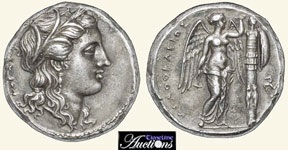
Agathokles Tetradrachm (Syracuse, ca. 305-295 BC.
Obverse; KOΡAΣ: head of Kore/ Persephone, wreathed with corn
AΓAΘOKΛEIOΣ (Agathocles): standing figure of Nike (Victory) attaching armour to trophy, triskeles to the right
Adapted from Wildwinds ( BMC 379)
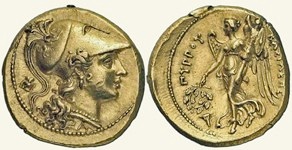
Pyrrhus: Gold stater (Syracuse): Obverse: Head of Athena, wearing a Corinthian helmet
Reverse: ΒΑΣΙΛΕΩΣ ΠΥΡΡΟΥ (of King Pyrrhus): ‘floating’ Nike, holding a trophy and a wreath; bucranium below
From Mike Markowitz, for CoinWeek (2020), at p. 6
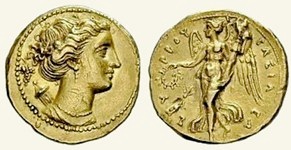
Pyrrhus: Gold half stater/ decadrachm (Syracuse): Obverse: Head of Artemis, quiver over shoulder, grapes behind
Reverse: BAΣIΛ-EΩ-Σ ΠΥPPOΥ: floating’ Nike, holding a trophy and a wreath; thunderbolt below
From Mike Markowitz, for CoinWeek (2020), at p. 5
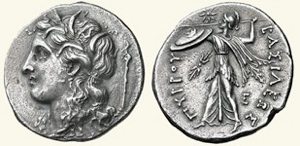
Pyrrhus: Silver octobol (Syracuse): Obverse: Head of Kore/ Persephone, left, wreathed with grain, torch behind
Reverse: BAΣIΛEΩΣ ΠΥPPOΥ: Athena, with spear and shield, thunderbolt in front, star above
From Mike Markowitz, for CoinWeek (2020), at p. 3
According to a summary by Pompeius Trogus, as epitomised by Justinus,Pyrrhus, having been invited by the Sicilians for the purposes of driving the Carthaginians out of the island:
“... crossed over to Syracuse and, taking several cities [from Carthaginian control], received the title of king of Sicily [in addition to his existing status as] king of Epirus. Elated by this success, he planned to assign:
✴the kingdom of Sicily to his son Helenus as an inheritance from his grandfather (for Helenus’ mother had been a daughter of [King Agathocles of Syracuse, whom Pyrrhus had married in 295 BC]; and
✴that of Italy to [his other son], Alexander.
He then fought many successful battles with the Carthaginians. However, after a time, ambassadors came to him from his Italian allies, announcing that they could no longer withstand the Romans and that, unless he gave them assistance, they must submit. ... [He therefore decided] to exert his utmost strength in Sicily and then, after having subdued the Carthaginians, to carry his victorious army into Italy. He therefore fought a battle [against the Carthaginians] but, although he claimed victory, as he hurriedly left Sicily, he seemed to flee as one defeated. His [Sicilian] allies therefore revolted ... , and he lost his dominion in Sicily as speedily and easily as he had obtained it”, (‘Epitome of Pompeius Trogus' Philippic Histories’, 23: 3: 1-10).
278/11 Sicilians send an embassy to Pyrrhus, asking him to help them against
278/19 with the Carthaginians and try to stop Pyrrhus crossing to Sicily.
278/28 Pyrrhus leaves Italy and crosses over to Sicily.
278/29 Pyrrhus arranges peace between Thoenon and his opponents at Syracuse.
278/30 from many Sicilian cities come to Pyrrhus offering their support.
277/1 Pyrrhus takes control of Acragas and 30 other cities that had also belonged to Sosistratus.
277/2 Pyrrhus attacks the territory of the Carthaginians in Sicily.
277/12 Pyrrhus captures Eryx.
277/13 rest of the Carthaginian possessions in Sicily go over to Pyrrhus.
277/14 Pyrrhus defeats the Mamertines.
276/2 Negotiations between Pyrrhus and the Carthaginians.
276/3 Pyrrhus prepares to attack Lilybaeum.
276/4 Pyrrhus has Thoenon of Syracuse killed on suspicion of treason, and and his despotic behaviour makes him unpopular with the Sicilians
276/11 Pyrrhus abandons the siege of Lilybaeum.
276/17 The Italians appeal to Pyrrhus to return to help them.
276/18 Pyrrhus defeats the Carthaginians in a final battle.